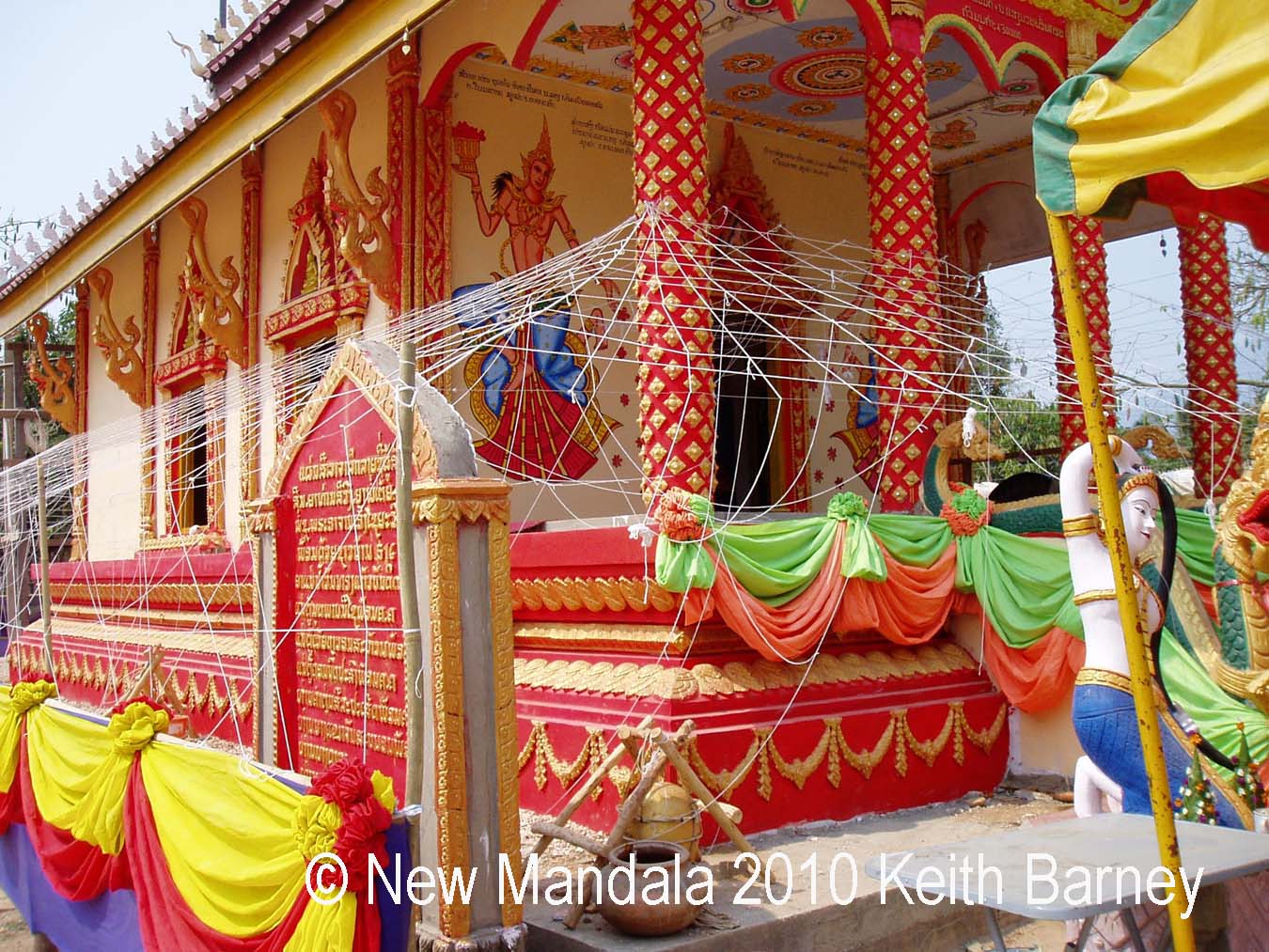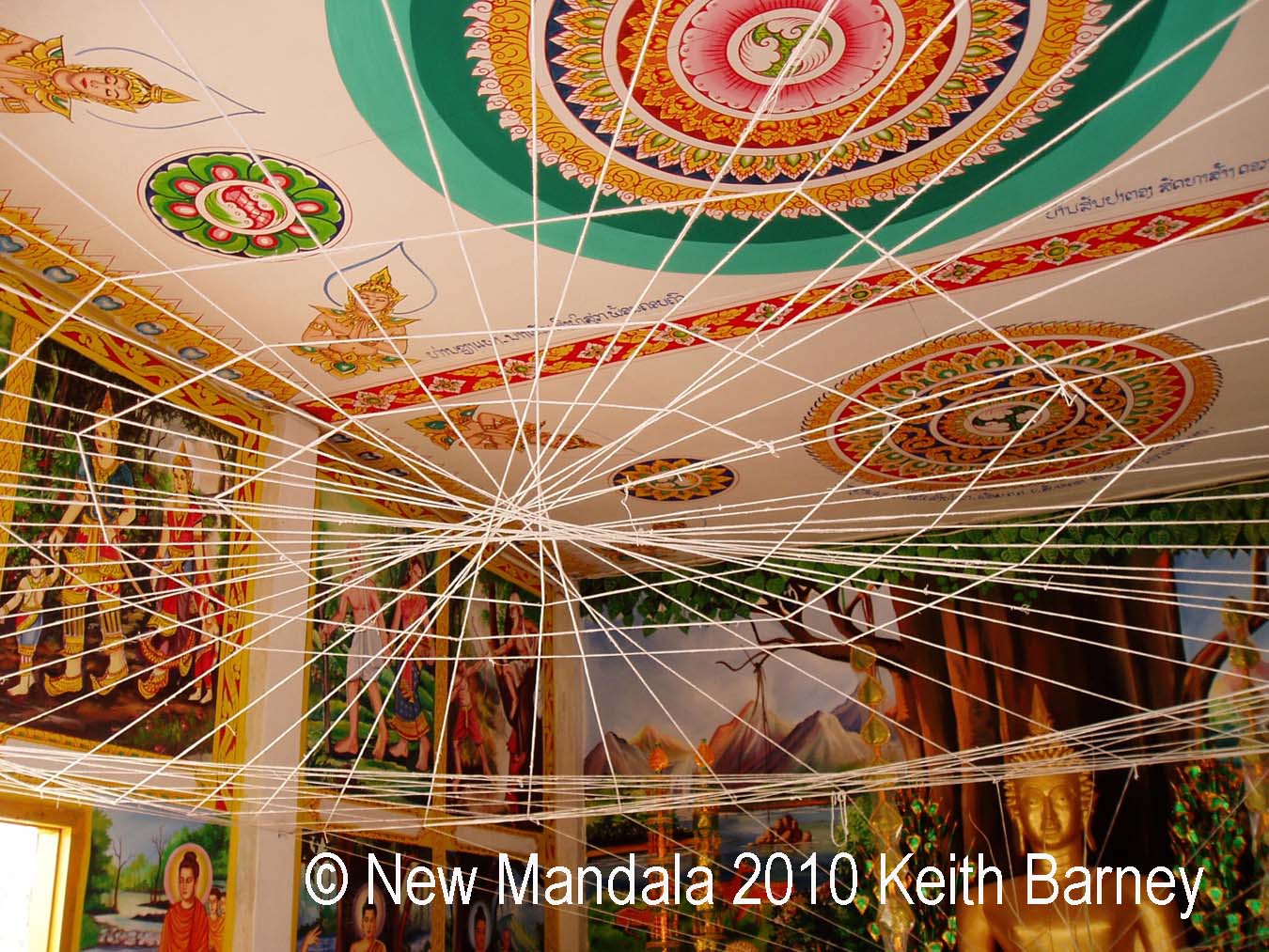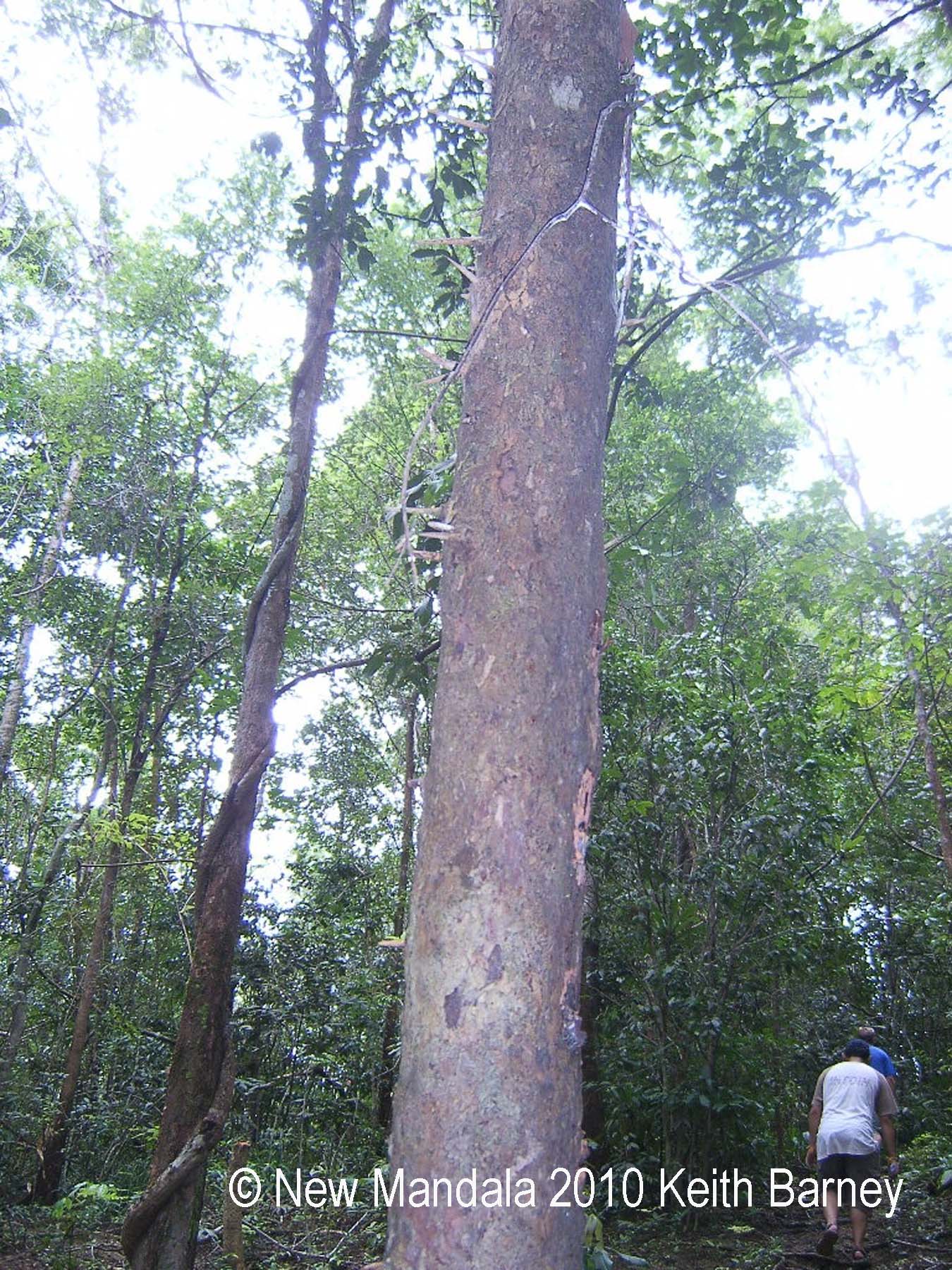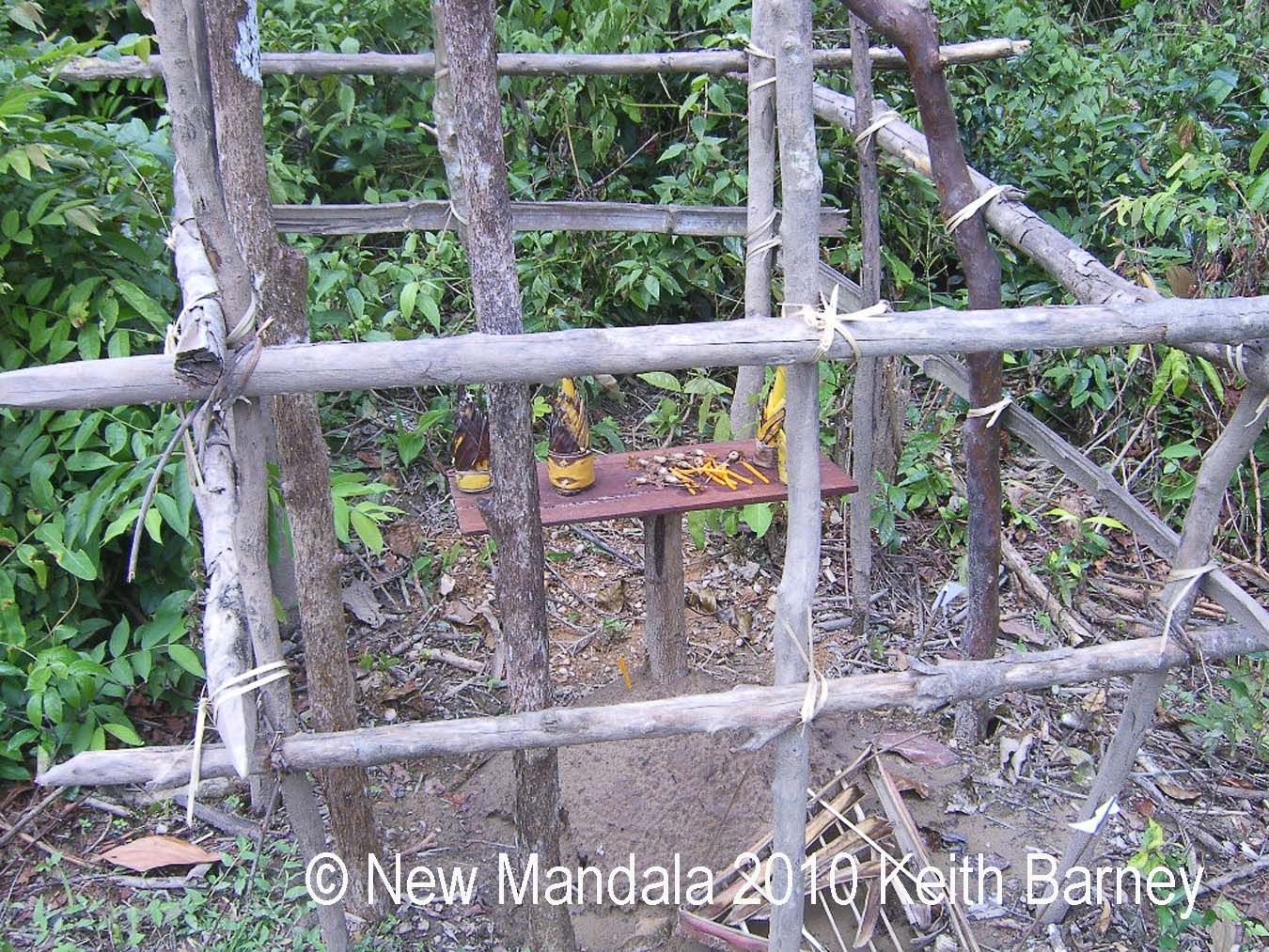I like the string metaphor or ‘string theory’ for understanding decentered, radiating networks of connection, forming across space and across hierarchies. Actual strings of course often appear in Lao vats (see below photographs from a temple in the area of the Nam Ngum reservoir in Laos), and during baci festivals.
I might also propose another aspect to the string-network metaphor however, one which does not entirely do away with more ‘dualist’ notions of center-periphery, domination- resistance, urban-rural, and the forceful incorporation of communities into nation-states and global markets. That is, strings might also be deployed in a defensive manner, for the purposes of community protection, in the face of what could be called ‘intrusive’, external forces. Let me explain.
In 2008, while on my last fieldtrip to a village in Hinboun District which I have visited often over the past few years, I came across a potentially interesting example. This is the same village which I wrote about in a working paper, [insert link to New Mandala posting: “Power, Progress and Impoverishment].’ In that working paper I showed how this rural Lao community was being rather negatively affected by two large-scale resource megaprojects. The first was the Oji Laos Plantation Forestry Ltd. pulpwood concession project, and the second, the Theun-Hinboun hydropower project (and the Theun-Hinboun expansion project). I took care to emphasize how the people in this community were engaged in imaginative and flexible responses to the resource enclosures produced by these companies, including engaging with the company’s compensation and mitigation schemes, autonomous experiments with smallholder rubber planting, and new and extensive youth labour market outmigrations to Thailand.
Being situated in the Hinboun valley and relatively close to the Thai border, there are also a host of broader agrarian changes coming into the district, linked to regional integration process and Lao state policy reforms, which makes the whole situation on the ground quite dynamic and multi-faceted. Nevertheless, I think I documented fairly well how this village was getting a raw deal out of their interactions with the resource companies in question, despite the latter’s rhetoric of “power, progress and corporate partnership.” In particular, I pointed to the way in which the social-ecological outcomes of hydropower and industrial tree plantation development were producing cascading, cumulative enclosure effects in this village. This situation poses significant challenges for efforts to adequately understanding social-environmental impacts, and in the provision of effective social compensations and mitigations. The overall picture I came away with, from spending a many months on fieldwork in this village, was a community under significant stress. Villagers were experiencing sharp transformations and dislocations, beyond anything they had previously encountered, although many were experimenting with new livelihood options, some even with a degree of success.
On my last trip to this village, in September 2008, I was out with a field assistant, and a colleague from a provincially-based NGO, taking a walk through the village upland forests and having a look at the new swidden fields, the farmer-rubber plots, and the new forest-lands that had been cleared by Oji LPFL. We also took a walk through the village protected forest, in the area that villagers call phou din bed, or ‘Duckfoot Mountain’ (this is zoned in the Land and Forest Allocation map as pa pongkan). What was interesting is that we came across evidence that somebody, perhaps a villager, a worker from Oji LPFL, or someone else, had been cutting down some large trees and sawing them up. Of course, this is against both official regulations, and local customary practice.
As you can see, there are some mature hardwood trees in this area of forest at the top of Duckfoot Mountain that would probably be worth in the hundreds or thousands of dollars each. These hardwoods thus make a tempting target for both locals, and any outsiders who could now access these valuable forests, via the new Oji LPFL plantation access roads. I was going to inquire with the nai ban concerning who had cut these trees, and indeed whether he was aware of it. Although I thought this would need to be handled somewhat discretely–after all he might be well aware of the perpetrator.
On our way back to the village, I came across a phi spirit shrine in the far northeast corner of the village proper, behind the schoolhouse. This was a new shrine, which had not been there before, so I snapped a photo.
Upon returning to the headman’s house, I took a photo of the old irrigation pumps, sitting up on the riverbank. Since the time of writing my 2007 working paper, a new piece of graffiti had appeared on the pontoon. The first piece graffiti read kwaan jai sao naa–an ironic statement which pointed to how useless this irrigation boat was for the purposes of re-constructing their livelihoods (it’s a long story, but the motor pumps were given away to another village, after the naa seng/dry season irrigated rice project sponsored by GoL and THPC had collapsed in this village).
The new piece of graffiti was another dryly ironic statement (see photo). It reads naa seng haeng, or ‘naa seng– divorced.’ Again, this seems to be drawing attention to the failure of THPC to provide effective livelihood compensation for the loss of the village’s wet rice paddy along the Hinboun River. These paddy fields had to be abandoned due to the post 2001 wet season flooding regime, which both villagers and external experts have linked to the outcomes of inter-basin transfer THPC project. [One can also note in the photo, the latest THPC ‘livelihood replacement’ scheme– the headman’s mini-fish pond, under the blue netting in the left of the photo. You can also see, behind the pontoon boat, the THPC–sponsored outhouse. Nobody in the nai ban’s household actually uses this facility (except, on one occasion, as a storage room for a butchered buffalo), but is otherwise nice for visiting officials and researchers to use. So the graffiti seemed to indicate the same old story. Lots of promises and launching of new livelihood projects by the companies, not much in the way of actual benefits reaching the villagers.
So I was looking at the irrigation boat (you can see some of my wet clothes drying off the bamboo pole in the photo). And then I noticed this… string… running through the trees behind it (the string is actually visible in the photo, at the right side, running under the boat’s roof). At first I thought that the string was part of a child’s game. But then I saw that the string was also continuing in either direction towards the other houses. In fact, as I followed it, the line of string wrapped around the entire village household space (the khet khoom khorng khong ban, in official parlance). And in addition to the string, as I walked through the vat compound, I also came across these little sand stupas, just a few inches high, with candles in them, located in various spots on the temple grounds.
I was intrigued. Something was up.
The story, the nai ban said, was that the villagers recently held a ceremony called a sud– (and if anyone else has any information on this type of ritual I would be very interested to hear more about it). A monk to officiate the sud, and the villagers made a spirit shrine, the sand stupas, and wrapped a string around the village common. According to the nai ban, the villagers requested that a monk come to visit them (there is no permanent monk based in this rather poor village) and perform the ceremony because a malevolent female spirit, a certain Nang Tiem, had been causing people to fall ill. Not less than four village women had fallen sick within a week, and one young man had also fallen down shaking with convulsions (these five people are all close neighbours in the village housing arrangements). The headman stated that Nang Tiem had come to visit the villagers, because some people– he did not say who– had and cut down and removed a number of large trees in the protected/spirit forest. Was the perpetrator the young man who had fallen down shaking, or someone from outside the village? (I had the sense that it was not polite to ask).
We did the sud ceremony on September 11, and now everyone feels better.
We also tied the string around the village, and made the sand stupas. This is the first time we have ever done this ceremony in this village, it is only something we might do if many people fall sick or die.
There are a number of ways of interpreting what was going on here, and I am reticent to build this into too much of an ‘interpretive framework’, especially based on what little information I have. But what does seem clear is the use of Buddhist and phi rituals, including strings, in forming a kind of protective counter-measure in the face of transgressions to village customary belief and spirit worship, specifically as related to sacred village spaces and villager’s management of the natural environment. Whether the villagers called for an emergency sud ritual as a response to the loss of a few valuable trees on Duckfoot Mountain, or whether the call for the ceremony can also be understood as a reflection of the wider stresses that the community is experiencing, including the multiple land and river enclosures linked to Oji LPFL and THPC; the prospect of wholesale village relocation away from the river, due to the Theun-Hinboun Expansion Project; and the rapid outmigration (in some cases with very young teenagers, this could be considered as a form of human trafficking) of almost all of the village youth to illegal or precarious work sites in Thailand, I cannot say. However, the idea that the villagers have never in living memory previously performed this ritual implies that some rather exceptional circumstances were at work.
So I might suggest, tentatively, another possible reading of the string metaphor, which goes beyond something benign or inert. In addition to the understanding strings as a ‘new mandala’ network, a metaphor of multi-scaled connection, and as connections between community, state, and market, strings might also be understood as involved in the making and maintaining of a community sense of place and social-landscape. Perhaps, in certain circumstances, material and symbolic strings can even be deployed as a kind of protective force, used in the buttressing of a community’s sacred territorial power, and village cohesion, in a context of rapid, externally-driven socio-cultural dislocations and landscape enclosures.
If anyone else has ever come across such a sud string ritual in Laos, again I would be really interested to learn more.
 Facebook
Facebook  Twitter
Twitter  Soundcloud
Soundcloud  Youtube
Youtube  Rss
Rss 



